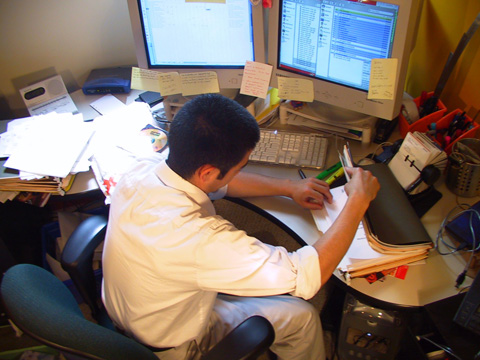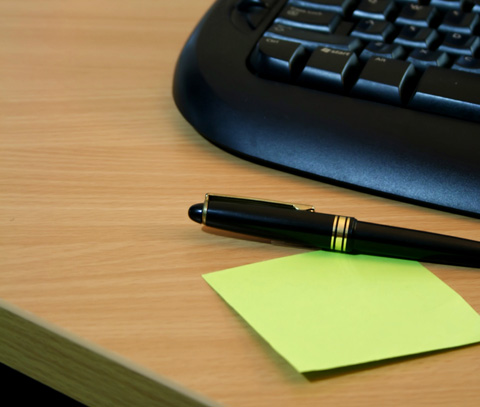How To Find Time For… Everything!
Successful time management can be challenging, especially to those who are new to freelancing or being self-employed. When you have a boss telling you what to do and when to do it by, it’s much easier to prioritize and figure out what needs to be done and when. But when you’re not only dealing with client deadlines but also all of the day-to-day parts of running a business, on top of trying to maintain some sort of life outside of work, time management gets a whole lot trickier.
Below are sixteen tips to help you better manage your time and find the time to participate in the things that are important to you. Also included are some further resources to improve your time management.
1. Get Organized
Taking time away from your work to find things, whether on your computer or your physical desktop, can be one of the biggest time-wasters out there. This is one of those things that varies a lot by industry and personal preference, but you absolutely need to have a system in place to handle the information, files, and data that comes your way each day. This might include folders and tags on your computers, or file-folders, piles, and inboxes in your physical workspace.

Experiment with different organizational systems until you find one that really works for you. Personally, I have a folder called “work” on my desktop and within that I have folders for each client I work with on a regular basis. For one-off projects I’ll create a folder for that client while I’m working on the project, and then those folders will get moved into a “completed” folder once the project is over (and usually moved to my portable hard drive instead of remaining on my laptop’s hard drive). I have very little physical paperwork, so piles on my desk work just fine for me.
2. Separate Work Space from Everything-Else Space
You need to have a dedicated workspace. If you work in an office, this is easy enough to manage. But if you work from home, you’ll need to put a bit more effort in. Here are a few tips for creating a workspace if you don’t have space for a dedicated office:
- Get a desk.
Don’t try to work from your coffee table or dining room table. It’s inefficient and you’ll constantly find yourself having to pick things up just to bring them back out later. It’s better to have a space where you can leave your work things set up all the time. - Go into “work mode” when you’re in your workspace.
This might mean wearing “work clothes” when you’re working. Or it might mean putting shoes on when you’re at your desk (this is one I do most of the time). - Steal unused space.
Is there an unused room, corner of a room, or even closet somewhere in your home? Is it big enough for a desk? If it is, then you might have just found your dedicated office. If your space is part of a larger room, consider buying an office armoire to hide away your work stuff when you’re not using it. If it’s in a closet or other tiny space, a built-in desk and shelving might work best (otherwise you’re likely to waste space with a desk that’s smaller than the total space). Commandeer unused space in your home to carve out a dedicated work space.

3. Take Advantage of Time Management Tools
There are hundreds of tools out there for organizing and managing your time. Whether you opt for a physical date book or calendar or go for an online app, take advantage of the ready-made tools available. I use a combination of tools. Remember the Milk keeps my to-do list (with the Pro version you can also access it from an iPhone). I have a dry-erase calendar for my monthly schedule. And I flag emails that have important information in them until I’m done with that information.

Previously, I’ve used those yellow Post-It notes to keep my to-do list organized (I’d stick them to my desk in front of my keyboard) and a pocket-size black Moleskine notebook. Both tools worked well, but I finally decided I wanted to have a to-do list I could access from anywhere.
There are tons of other time management tools. Experiment with a few and see what seems to fit with the way you work. There’s no “one-size-fits-all” solution out there that will work for everyone. But there’s almost certainly a tool out there for everyone.
4. Set Goals
Setting goals is one of the most important things you can do to manage your time. If you don’t have any goals, how do you know what’s important? What deserves your time and attention? The short answer is: you don’t.
Goals don’t need to be formal. They don’t need to be long-term either (though long-term goals can also help). What they do need to do is focus your attention on what’s important.
One of my goals might be to get all of my work done by Thursday so I can take Friday off, or use Friday to work on a personal project. What that goal does is get me to focus on working more efficiently so I can finish my work in 80% of the time. Cutting 20% of my work time isn’t that big of a deal most weeks. Simply turning off TweetDeck while I work (or setting it to only pull updates every 30 or 60 minutes) can go a long way toward doing that. So can working through lunch or getting up a half hour earlier (or staying up a half hour later).
Your goals should be attainable and specific. You can set recurring goals (“I want to take every Friday off.”) or one-time goals (“I want to finish my new website design by next Tuesday.”) or any combination of the two. You might write them down somewhere or you can just keep them in your head. Just make sure you always have a goal. Your goal could even be as simple as, “finish this logo mockup before lunch.”
5. Set Deadlines
Deadlines are sort of like a built-in goal for a project. If you know something is due next Monday, then you’re more likely to structure your work on it to make sure it gets done by Monday. (If not, you definitely need this article more than most.)

If you don’t have deadlines imposed by clients or a boss, then you’ll need to have self-imposed deadlines. Think about when you want to finish something or when you’d like to move on to the next project. Put that date in your calendar or mark it on your to-do list as the deadline for your current project. For added accountability, tell someone else about your deadline. I’ll sometimes post self-imposed deadlines on Twitter or Facebook so my friends there can hound me about it if I miss a deadline. Peer pressure can go a long way toward getting you to work harder.
6. Plan Ahead
Keep some kind of big-picture plan. This might be monthly, bi-monthly, or yearly, depending on your industry and the particular types of projects you take on. As I mentioned before, I keep a dry-erase calendar with my monthly projects and deadlines. I can also mark down appointments, important dates, and other information that might interfere with my deadlines or regular work schedule. Most of my deadlines are on a weekly or semi-weekly basis, so a monthly calendar works great for me. If you have longer deadline periods (or shorter ones), you’ll need to adjust the amount of time you need to look at at once to get an idea of how much work you’ve committed yourself to at any one time.

7. Prioritize
You have to prioritize the work you do. For the most part, work due immediately (or within the next few days) should be completed first. Then comes the work due within the next week or two, and then everything else.

Don’t forget to include family priorities, too. Your child’s first soccer game is important, so make sure that gets on the list of top priorities. Doctor’s appointments, school plays, parent-teacher meetings, date nights, and parties also need to be taken into account when you’re planning your work schedule. Decide what things you absolutely must attend whether your work is finished or not (there shouldn’t be very many things on this list), what things you want to attend if you get to a certain point in your work (and note what you need to have done in order to attend), and things that you may or may not attend if all of your work is finished.
Set up a system of marking the priority of different items on your schedule. This might be using different-colored pens to write in different items, or it might be putting a star next to the most important things, or even keeping separate lists for each priority. Again, just make sure whatever you choose to do makes sense in your lifestyle.
8. Delegate or Outsource
There’s nothing wrong with bringing in a little outside help once in awhile. This might mean delegating responsibility for a project to someone else in your office, or even to an assistant. It might mean outsourcing a certain aspect of a project (research, coding, etc.) to someone else so you can focus on the more important parts.
You don’t necessarily need to outsource or delegate parts of your work to be more effective. Why not consider hiring a housekeeper to come in and clean your house once a week? Or getting someone else to wash and detail your car instead of spending Saturday afternoon doing it yourself? These kinds of outsourced services can free up your time for the important things you want to do (like hanging out with your significant other or your kids, or playing an extra round of golf).
9. Optimize Your Processes
There are almost certainly things you do on a daily or weekly basis in the course of your work that you could streamline. It might be your billing. Or maybe your archiving. Or it could be something you do on almost every project you take on.
These are the things you should streamline and optimize. Look at the way you’re currently doing things and see if there are steps you could combine or cut all together. If you’re a web designer, this might mean creating your own custom set of template files for developing sites. Or using an automated invoicing program for billing. Or any number of other things that can be made more efficient if you’re only willing to take the time to identify them.
10. Learn to Say “No”
One of the biggest time-management pitfalls you can experience is taking on too much work. You have to learn to say “no” to some people. If you take on more work than you can handle, not only will you have problems meeting deadlines, but the quality of your work and your relationships (both personal and work-related) will suffer.
Before taking on any new work, look at your schedule. Do you really have time for another project? If not, simply explain to the client that you have too many projects going to devote the time necessary for their project. Most will thank you for it. And if you really can’t bring yourself to turn down work, give them a realistic timeline for when you can complete their project. Don’t say you can have it done the following week if you already have commitments taking up your time between now and then.

The same principle goes for personal obligations, too. Nothing says you have to serve on your homeowners’ association board. You don’t have to join the PTA or your local indoor soccer league. And just because you’ve done something every year for the past ten years doesn’t mean you have to do it every year for the next ten. Learn to say no to your friends, family, neighbors, and others in your life so you have time to say “yes” to the things that are really important to you.
11. Learn When You Work Best
One of the advantages to being a freelancer is that you can set your own hours. Pay attention to when you’re mot productive. For me, that’s from about nine in the morning until around two or three, and then again from about six or seven in the evening until eleven or twelve. I don’t force myself to work in those hours when I know I’m not productive (from 2-7 most days). But I make sure that I’m in work mode in the morning and then again late in the evening so I can get more done when I am productive.

12. Set Regular Working Hours
This is related to when you work best. You should have regular working hours that you try to stick to every day. If you work best from 4:00AM until noon, then work every day during that time. That also means that you should stop work at noon and go do something else. The same goes fro weekends. Take at least two days a week off if at all possible. It doesn’t necessarily have to be Saturday and Sunday; you might choose to take Wednesday and Thursday off or Monday and Tuesday. Whatever works for you. Just make sure you have some down time when you’re not working. Otherwise you’re likely to end up burning out.
13. Don’t Waste Time
Look at the things that waste time during your day. Are you constantly checking Facebook or Twitter? Getting up to get a glass of water? Taking your dog for his sixth walk this afternoon? Whatever these things are, try to figure out ways to minimize their ability to interrupt you. Take the dog for a nice, long walk right after lunch. Only check Facebook or Twitter once an hour (or every two hours); keep them closed other than at their allotted times. Get a refillable water bottle so you only have to get up a couple times a day. Identify what you waste time doing and eliminate it.

14. Avoid Multitasking
Multitasking works in some circumstances. But when it comes to getting any substantial work done, multitasking usually does more harm than good. Work on one project at a time. This doesn’t mean you necessarily have to work on one project until it’s completely finished, but it does mean you shouldn’t skip back and forth between three projects every two minutes. Set yourself a minimum work time; it might be fifteen or twenty minutes or even an hour, and then work on just one project during that time.
The multitasking advice also applies to trying to work while you’re checking your email, playing solitaire, talking on the phone, and any other distractions that prevent you from dedicating your full attention to the task at hand.
15. Take Frequent Breaks
Burnout is a huge bar to productivity. When you get burned out you end up unable to focus or complete work as quickly as you might otherwise (if you can work at all). Taking regular breaks from your work helps prevent burnout. This might mean going for a walk in the middle of the day, taking a break to watch the news after lunch, doing your shopping in the midafternoon instead of in the evening, or even taking a week off a couple times each year for vacation.
These little breaks refresh us and keep us eager to work. Without them we grow tired and our concentration lags. I generally take a couple hours each afternoon and get out of my house. This might mean going to visit relatives, doing some shopping, going for a drive or a walk, a short hike, or swimming in the summer. I also take a few five or ten minute breaks throughout the day to recharge and rest my eyes (staring at a computer screen all day is very hazardous to your vision). And I take long weekends (3 or even 4 days off) on a regular basis to recharge.

16. Maintain
Maintenance is incredibly important to any time management system. But it’s not just your system you need to maintain. It’s all the parts of your life that you need to keep running smoothly in order to get your work done.
This means basic maintenance on your computer (backing up files, emptying your trash, cleaning out your inbox), basic maintenance on your office or workspace (dusting, emptying the trash, vacuuming, etc.) and basic household maintenance (washing dishes, doing laundry, home repairs, etc.).
Don’t overlook maintenance on yourself, either. Getting some exercise every day and eating right can go a long way toward making you more productive.

You might be asking yourself what this has to do with finding time to do things in your life. Well, here’s the thing: If you don’t maintain all the things in your life that need it, eventually something is going to fail. This might be something as simple as having to take time out on a work day to do laundry because you’re completely out of clean clothes, or it might be something more major like a preventable illness or injury. When unexpected disasters crop up, they wreak havoc on our productivity. You end up spending more time playing catch-up than you would have if you had just maintained things in the first place. And if you include regular maintenance in your schedule, they really don’t take up much time at all.
Further Resources:
- 10 Tips for Time Management in a Multitasking World A great article from Brazen Careerist on time management.
- 11 Time Management Tips An excellent time management article from About.com.
- 43Folders A blog devoted to the Getting Things Done system and other personal productivity and time management topics.
- How I Work in Chunks An article covering one method of time management.
- GTD Toolbox: 100+ Resources for Getting Things Done One of my own articles, a roundup of time management and productivity tools.
Further Reading on SmashingMag:
- Effective Strategy To Estimate Time For Your Design Projects
- 6 Simple Ways For Freelancers To Increase Productivity
- 20 Time-Saving Tips to Improve Designer’s Workflow




 Flexible CMS. Headless & API 1st
Flexible CMS. Headless & API 1st


